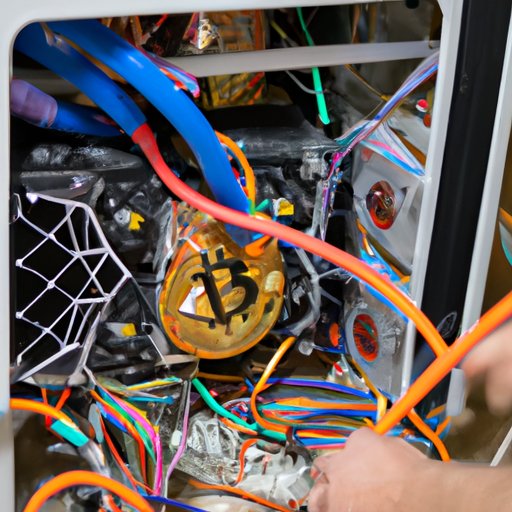Introduction
With the rise of cryptocurrencies like Bitcoin, more people are becoming interested in the world of digital assets. One of the most important components of this new technology is the concept of mining, or the process by which new coins are created and transactions are validated on the blockchain. In this article, we’ll explore what are Bitcoin miners and how they work.
Exploring the World of Bitcoin Mining: What Are Bitcoin Miners?
In the simplest terms, Bitcoin miners are the individuals or entities responsible for processing Bitcoin transactions and securing the network. They do this by using specialized computers to solve complex mathematical equations that verify each transaction and add it to the blockchain. The miners are then rewarded with newly-created Bitcoins as well as transaction fees.
There are several different types of Bitcoin mining, including solo mining, pool mining, cloud mining, and ASIC mining. Solo miners use their own computing power to mine for Bitcoins, while pool miners combine their computing power with other miners to increase their chances of finding a block. Cloud mining involves renting the computing power of a third-party server, while ASIC miners use specialized hardware designed specifically for mining.
An Overview of Bitcoin Mining: What Do Bitcoin Miners Do?
The role of Bitcoin miners is to process transactions and secure the network. This is done by verifying each transaction and adding it to the blockchain. The miners receive rewards for their efforts in the form of newly created Bitcoins and transaction fees. By verifying transactions and securing the network, miners help ensure that the Bitcoin network remains decentralized and secure.
In addition to verifying transactions, miners also help to prevent double spending, which occurs when someone attempts to spend the same Bitcoin twice. By verifying each transaction, miners can ensure that the same Bitcoin is not spent twice, thus preventing fraud and ensuring the security of the network.
A Comprehensive Guide to Bitcoin Mining: How Does It Work?
The process of Bitcoin mining involves using special software and hardware to solve complex mathematical equations. When a miner finds a solution to the equation, they are rewarded with newly created Bitcoins and transaction fees. This process is known as proof-of-work (PoW), and it is an essential part of the Bitcoin network.
Mining hardware consists of specialized computers designed to solve the complex equations required to mine Bitcoin. These computers are highly efficient and require a lot of electricity to run. Mining software helps miners to connect to the Bitcoin network and manage their mining activities.
The Basics of Bitcoin Mining: Who Are Bitcoin Miners?
Anyone can become a Bitcoin miner, but it requires a significant investment in hardware and electricity. As such, most miners are large companies or organizations that have the resources and expertise to invest in the necessary equipment. However, there are some individuals who are able to make a profit from mining, especially if they are able to find a low-cost source of electricity.
The profitability of Bitcoin mining depends on the price of Bitcoin, the cost of electricity, and the efficiency of the mining hardware. If the price of Bitcoin is high enough, miners can earn a profit even with a small amount of computing power. However, if the price of Bitcoin falls or the cost of electricity rises, miners may struggle to stay profitable.
What Is Bitcoin Mining and How Does It Work?
Bitcoin mining is the process of verifying and adding transactions to the blockchain. Miners use specialized computers to solve complex mathematical equations in order to verify each transaction and add it to the blockchain. For their efforts, miners are rewarded with newly created Bitcoins and transaction fees. This process is known as proof-of-work (PoW) and is an essential part of the Bitcoin network.
The process of mining begins with miners connecting their computers to the Bitcoin network. Once connected, miners use their computers to solve complex equations in order to verify each transaction and add it to the blockchain. If a miner is successful in verifying a transaction, they are rewarded with newly created Bitcoins and transaction fees.
Understanding the Role of Bitcoin Miners: What Do They Do?
The role of Bitcoin miners is to verify transactions and secure the network. This is done by solving complex mathematical equations in order to verify each transaction and add it to the blockchain. Miners are rewarded for their efforts with newly created Bitcoins and transaction fees.
In addition to verifying transactions, miners also help to prevent double spending, which occurs when someone attempts to spend the same Bitcoin twice. By verifying each transaction, miners can ensure that the same Bitcoin is not spent twice, thus preventing fraud and ensuring the security of the network.
Conclusion
In conclusion, Bitcoin miners are responsible for verifying transactions and securing the network. They do this by using specialized computers to solve complex mathematical equations in order to verify each transaction and add it to the blockchain. Miners are then rewarded with newly created Bitcoins and transaction fees. Although mining can be profitable, it requires a significant investment in hardware and electricity.
The process of Bitcoin mining is an essential part of the Bitcoin network, and miners play a critical role in helping to keep the network secure and decentralized. By understanding what are Bitcoin miners and how they work, we can better understand the importance of mining and its role in the cryptocurrency industry.
(Note: Is this article not meeting your expectations? Do you have knowledge or insights to share? Unlock new opportunities and expand your reach by joining our authors team. Click Registration to join us and share your expertise with our readers.)
